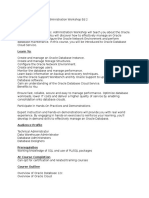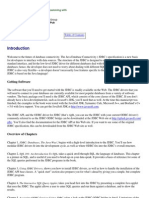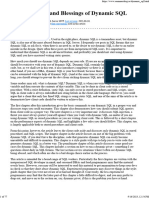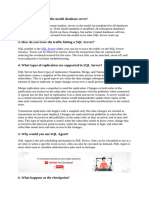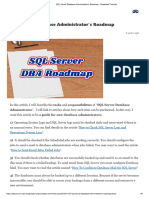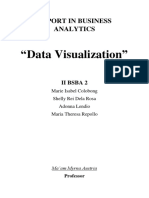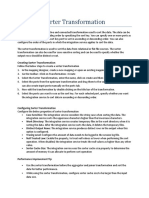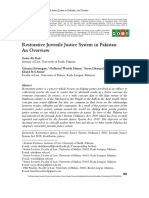Murach's SQL Server 2012 For Developers: Who This Book Is For
Murach's SQL Server 2012 For Developers: Who This Book Is For
Uploaded by
SrinivasCopyright:
Available Formats
Murach's SQL Server 2012 For Developers: Who This Book Is For
Murach's SQL Server 2012 For Developers: Who This Book Is For
Uploaded by
SrinivasOriginal Description:
Original Title
Copyright
Available Formats
Share this document
Did you find this document useful?
Is this content inappropriate?
Copyright:
Available Formats
Murach's SQL Server 2012 For Developers: Who This Book Is For
Murach's SQL Server 2012 For Developers: Who This Book Is For
Uploaded by
SrinivasCopyright:
Available Formats
Murach’s SQL Server 2012 for Developers
Every application developer who uses SQL Server 2012 should own this book. To start, it presents the
essential SQL statements for retrieving and updating the data in a database. You have to master these to
work effectively with database data in your applications. Then, it shows you how to design and create a
database, because application developers often end up in the role of database designer and DBA. Next,
it shows how to work with views, scripts, stored procedures, functions, triggers, cursors, transactions,
locking, security, XML data, and BLOB data with FILESTREAM storage. These features allow you to create
database applications that are thoroughly professional. Finally, this book shows how to use the CLR
integration feature and SQL Server Data Tools (SSDT), so you can use Visual Studio to code stored
procedures, functions, triggers, aggregate functions, and user-defined types in C# or Visual Basic.
Who this book is for
I think it’s fair to say that most developers don’t know enough about SQL and the database
management system they’re using. As one customer put it, “I know just enough about SQL
Server to be a little bit dangerous!”
That’s why developers often code SQL statements that don’t perform as efficiently as they ought
to. That’s why they aren’t able to code some of the queries that they need for their applications.
That’s why they don’t take advantage of all the features that SQL Server has to offer.
And that’s why this book should be required reading for every application programmer who uses
SQL Server. Beyond that, this is the right first book for anyone who wants to become a database
administrator. Of course, if you want to become a DBA, you’ll need to continue your study of
SQL Server’s advanced features after you finish this book…but you’ll be well-prepared to go on.
Table of Contents
Section 1: An introduction to SQL
Chapter 1. An introduction to relational databases and SQL
Chapter 2. How to use the Management Studio
Section 2: The essential SQL skills
Chapter 3. How to retrieve data from a single table
Chapter 4. How to retrieve data from two or more tables
Chapter 5. How to code summary queries
Chapter 6. How to code subqueries
Chapter 7. How to insert, update, and delete data
Chapter 8. How to work with data types
Chapter 9. How to use functions
Section 3: Database design and implementation
Chapter 10. How to design a database
Chapter 11. How to create and maintain databases, tables, and sequences with SQL statements
Chapter 12. How to use the Management Studio for database design
Section 4: Advanced SQL skills
Chapter 13. How to work with views
Chapter 14. How to code scripts
Chapter 15. How to code stored procedures, functions, and triggers
Chapter 16. How to work with cursors
Chapter 17. How to manage transactions and locking
Chapter 18. How to manage database security
Chapter 19. How to work with XML
Chapter 20. How to work with BLOBs
Section 5: CLR integration
Chapter 21. An introduction to CLR integration
Chapter 22. How to code CLR stored procedures, functions, and triggers
Chapter 23. How to code aggregate functions and user-defined types
Resources
Appendix A. How to install the required software for this book
Appendix B. How to install the files and databases used in this book
Appendix C. Coding and syntax conventions
You might also like
- Official Microsoft Learning Product 20461C Querying Microsoft SQL Server100% (2)Official Microsoft Learning Product 20461C Querying Microsoft SQL Server78 pages
- Module 1introduction To Microsoft SQL Server 2014100% (1)Module 1introduction To Microsoft SQL Server 201426 pages
- SQL Interview Questions: A complete question bank to crack your ANN SQL interview with real-time examplesFrom EverandSQL Interview Questions: A complete question bank to crack your ANN SQL interview with real-time examplesNo ratings yet
- SQL Exercises Using The Postgresql DbmsNo ratings yetSQL Exercises Using The Postgresql Dbms15 pages
- (Ebook) Practical SQL: Microsoft SQL Server T-SQL for Beginners by Mark O’Donovan ISBN 9781492753407, 1492753408 2024 Scribd DownloadNo ratings yet(Ebook) Practical SQL: Microsoft SQL Server T-SQL for Beginners by Mark O’Donovan ISBN 9781492753407, 1492753408 2024 Scribd Download86 pages
- Course 10776A Developing Microsoft SQL Server 2012 DatabasesNo ratings yetCourse 10776A Developing Microsoft SQL Server 2012 Databases9 pages
- [Ebooks PDF] download Practical SQL Microsoft SQL Server T SQL for Beginners Mark O’Donovan full chapters100% (3)[Ebooks PDF] download Practical SQL Microsoft SQL Server T SQL for Beginners Mark O’Donovan full chapters51 pages
- SQL For Beginners The Simplified Guide To Managing, Analyzing Data PDF100% (1)SQL For Beginners The Simplified Guide To Managing, Analyzing Data PDF109 pages
- Full Download Practical SQL Microsoft SQL Server T SQL for Beginners Mark O’Donovan PDF DOCXNo ratings yetFull Download Practical SQL Microsoft SQL Server T SQL for Beginners Mark O’Donovan PDF DOCX26 pages
- Buy ebook Practical SQL Microsoft SQL Server T SQL for Beginners Mark O’Donovan cheap price100% (5)Buy ebook Practical SQL Microsoft SQL Server T SQL for Beginners Mark O’Donovan cheap price60 pages
- Practical SQL - Microsoft SQL Server T-SQL For Beginners - Mark O'Donovan - Paperback, 2013 - Createspace Independent Publishing Platform - 9781492753407 - Anna's ArchiveNo ratings yetPractical SQL - Microsoft SQL Server T-SQL For Beginners - Mark O'Donovan - Paperback, 2013 - Createspace Independent Publishing Platform - 9781492753407 - Anna's Archive212 pages
- PDF (Ebook) Beginning SQL Server 2012 for Developers, 3rd Edition by Robin Dewson ISBN 9781430237501, 1430237503 download100% (1)PDF (Ebook) Beginning SQL Server 2012 for Developers, 3rd Edition by Robin Dewson ISBN 9781430237501, 1430237503 download72 pages
- Murach S SQL Server 2019 For Developers 1st Edition Joel Murach All Chapters Instant Download100% (8)Murach S SQL Server 2019 For Developers 1st Edition Joel Murach All Chapters Instant Download62 pages
- 6710cb971a4a7 1729153943 Ms SQL Server SimplifiedNo ratings yet6710cb971a4a7 1729153943 Ms SQL Server Simplified173 pages
- Introduction To Microsoft SQL Server 2014: Module OverviewNo ratings yetIntroduction To Microsoft SQL Server 2014: Module Overview16 pages
- SQL Tutorial For Beginners: Learn SQL in 7 Days: Training SummaryNo ratings yetSQL Tutorial For Beginners: Learn SQL in 7 Days: Training Summary7 pages
- Get (Ebook) Practical Graph Structures in SQL Server and Azure SQL: Enabling Deeper Insights Using Highly Connected Data by Louis Davidson ISBN 9781484294598, 9781484294581, 1484294599, 1484294580 free all chapters100% (3)Get (Ebook) Practical Graph Structures in SQL Server and Azure SQL: Enabling Deeper Insights Using Highly Connected Data by Louis Davidson ISBN 9781484294598, 9781484294581, 1484294599, 1484294580 free all chapters81 pages
- SQL - The Shortest Route For Beginners - Riaz Ahmed100% (1)SQL - The Shortest Route For Beginners - Riaz Ahmed159 pages
- Instant download Getting Started with SQL and Databases: Managing and Manipulating Data with SQL Mark Simon pdf all chapter100% (5)Instant download Getting Started with SQL and Databases: Managing and Manipulating Data with SQL Mark Simon pdf all chapter66 pages
- SQL Tutorial: 1 - SQL Quick Reference GuideNo ratings yetSQL Tutorial: 1 - SQL Quick Reference Guide1 page
- SQL Programming For Beginners The Ultimate Beginners Guide To Analyze and Manipulate Data With SQL (2020)No ratings yetSQL Programming For Beginners The Ultimate Beginners Guide To Analyze and Manipulate Data With SQL (2020)88 pages
- Oracle Database 12c - Administration Workshop Ed 2100% (1)Oracle Database 12c - Administration Workshop Ed 26 pages
- Get (Ebook) Murach's SQL Server 2019 for Developers by Joel Murach ISBN 9781943872572, 1943872570 free all chapters100% (9)Get (Ebook) Murach's SQL Server 2019 for Developers by Joel Murach ISBN 9781943872572, 1943872570 free all chapters55 pages
- Immediate download Getting Started with SQL and Databases: Managing and Manipulating Data with SQL Mark Simon ebooks 2024100% (3)Immediate download Getting Started with SQL and Databases: Managing and Manipulating Data with SQL Mark Simon ebooks 202441 pages
- OceanofPDF - Com Essential SQLAlchemy - Rick CopelandNo ratings yetOceanofPDF - Com Essential SQLAlchemy - Rick Copeland301 pages
- SQL Server 2014 With Powershell v5 Cookbook - Sample ChapterNo ratings yetSQL Server 2014 With Powershell v5 Cookbook - Sample Chapter39 pages
- en-US Library Ms345147 (D Printer, V SQNo ratings yeten-US Library Ms345147 (D Printer, V SQ11 pages
- What Purpose Does The Model Database Serve?: SQL ServerNo ratings yetWhat Purpose Does The Model Database Serve?: SQL Server10 pages
- SQL Server Mastery: Advanced Techniques for Database Optimization and AdministrationFrom EverandSQL Server Mastery: Advanced Techniques for Database Optimization and AdministrationNo ratings yet
- Addison Wesley The GuruS Guide To SQL Server Architecture and Internals 2003 Ken Henderson PDFNo ratings yetAddison Wesley The GuruS Guide To SQL Server Architecture and Internals 2003 Ken Henderson PDF1,367 pages
- Top 30+ Best Oracle Apex Interview Questions and Answers in 2022No ratings yetTop 30+ Best Oracle Apex Interview Questions and Answers in 202215 pages
- SQL Server Database Administrator's Roadmap - Database Tutorials - DBA GuiaNo ratings yetSQL Server Database Administrator's Roadmap - Database Tutorials - DBA Guia9 pages
- Objective: Maintain SQL Server Instances. Sub-Objective: Manage SQL Server Agent OperatorsNo ratings yetObjective: Maintain SQL Server Instances. Sub-Objective: Manage SQL Server Agent Operators7 pages
- Bibliomining For Library Decision-Making: BackgroundNo ratings yetBibliomining For Library Decision-Making: Background1 page
- Machine Learning Tools: (Scherf Et. Al. 2005)No ratings yetMachine Learning Tools: (Scherf Et. Al. 2005)1 page
- Bibliomining For Library Decision-Making: Key TermsNo ratings yetBibliomining For Library Decision-Making: Key Terms1 page
- Best Practices in Data Warehousing: Les PangNo ratings yetBest Practices in Data Warehousing: Les Pang1 page
- The Framework For Behavioral Pattern-Based ClusteringNo ratings yetThe Framework For Behavioral Pattern-Based Clustering1 page
- A Bayesian Based Machine Learning Application To Task AnalysisNo ratings yetA Bayesian Based Machine Learning Application To Task Analysis1 page
- Key Terms: A Bayesian Based Machine Learning Application To Task AnalysisNo ratings yetKey Terms: A Bayesian Based Machine Learning Application To Task Analysis1 page
- Ex No:1 Datadefinition Commands, Data Manipulation Commands For Inserting, Deleting, Updating and Retrieving Tables and Transaction ControlstatementsNo ratings yetEx No:1 Datadefinition Commands, Data Manipulation Commands For Inserting, Deleting, Updating and Retrieving Tables and Transaction Controlstatements26 pages
- ERPSCM MM SRVServiceEntrySheet 180915 0417 1152No ratings yetERPSCM MM SRVServiceEntrySheet 180915 0417 11527 pages
- CICS Desk Reference Programs: Program Files and MapsetsNo ratings yetCICS Desk Reference Programs: Program Files and Mapsets2 pages
- Restorative Juvenile Justice System in Pakistan - An OverviewNo ratings yetRestorative Juvenile Justice System in Pakistan - An Overview17 pages
- Scalability and High Volume Performance of Indexer Clustering at SplunkNo ratings yetScalability and High Volume Performance of Indexer Clustering at Splunk44 pages































